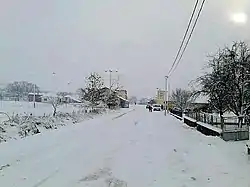Oplanići
Oplanići are populated city of Kraljevo in Raska district. According to the census of 2011, there were 899 inhabitants.[1]
Oplanići
| |
|---|---|
 | |
 Oplanići | |
| Coordinates: 43°43′31.8″N 20°40′30.6″E | |
| Country | |
| District | Raška District |
| Municipality | Kraljevo |
| Population (2011) | |
| • Total | 899 |
| Time zone | UTC+1 (CET) |
| • Summer (DST) | UTC+2 (CEST) |
| Postal code | 36000 |
| Area code(s) | +381 36 |
| Car plates | KV |
History
The village is mentioned Oplanići 1428/1429. year, as assumed under the name Platov, 1528. (18 houses) as above Svinjci 1560. (14 houses) in 1572 (11 houses) in 1595 under its current name, in 1844 (46 houses and 268 inhabitants ) and 1924 (115 homes and 730 houses). On maps from 1700, was first charted place Oplanići, exactly at the place where he led the border between Austria and Turkey. Through the centuries, the village has grown and developed and with it have changed the habits of its locals.
Geography
On the left side of the Western Morava River, at the foot of Kotlenik have settled Oplanići pleasant village, with both sides loklanog times Sirča-Milocaj. Oplanići is located 7 km from the town of Kraljevo. The village is situated at 271 m above sea level. On the left side of the Western Morava, Oplanići surrounding villages: Sirča, Popovici and Targovishte. And on the right side of the Western Morava two villages Grdica and Adrani.
Church of the Holy Archangel Gabriel in village Oplanići
Church in Oplanići dedicated to the Holy Archangel Gabriel, built in Annex villagers Oplanići and Popovic in the period of 1989 to 1991. At this same place there is a wooden church, which by tradition was built during the great migration of Serbs. Serbian Orthodox Church
Demography
In the village Oplanići live 750 adult inhabitants, and the average age is 43.2 years (41.7 for males and 44.7 for females). The village has 289 households, and the average number of members per household is 3.25 This village is largely populated by Serbs (according to 2002 census) 911 inhabitants, and the number of households 280 (according to the 2002 census), in the last three censuses, noticed a decline in population.
References
- Institut national d'études démographique (INED) Archived 2014-07-02 at the Wayback Machine


